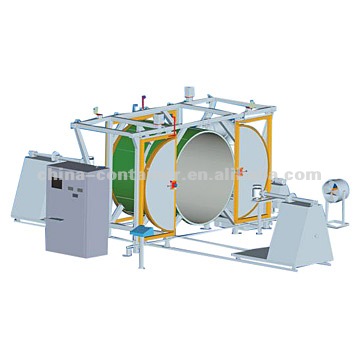Today, they are various plastic processing method available in industrial process, from the method of processing plastic we can divided into two big methods they are :
1. Molding Methodethis method usually use mold to melt the plastic, deformed with applied pressure and the product shape will same as the mold shape.
Various molding type method can be divided as
Extrusion Molding Method this process can produce along product with fixed cross-sectional profile such as wire and cable coating, plastic tube for printer ink, some hollow profile and various solid profile. the material is pallet or plastic chips that are usually dried in a hopper before going to the feed screw. to process extrusion method used injection machine, The plastic heated at barrel to molten state then forced through a plastic mold die that is in desired shape. look at picture below to learn more about extrusion mold.
 Injection Mold
Injection MoldInjection molding involves taking plastic in the form of pellets or granules and heating this material until a melt is obtained. Molten plastic is injected at high pressure into a mold, which is the inverse of the product's shape then it is allowed to cooling into the desired shape. The mold is then opened and the part is ejected, at which time the cycle is repeated. you should learn about various injection molds type at
mold construction postinjection mold method have various kind of techniques like Thermoplastic Foam Injection Molding, Multi injection mold (sandwich mold, bi injection mold) gas assist injection molds and other, basic injection machine for injection mold you can see at picture below

to learn more about injection mold you should open
introduction of injection molds post Blow Molding ProcessA thermoplastic resin is heated to a molten state It is then extruded through a die head to form a hollow tube called a parison. The parison is dropped between two mold halves, which close around it, the concept of blow mold you can see at picture below

we can divided blow mold four types as :
* Extrusion blow molding
* Injection blow molding
* Stretch blow molding
* Reheat and blow molding.
the picture above shown Stretch blow mold type, you should see more at
Blow Mold PostingCompression MoldsCompression molding is a method of molding in which the plastic, generally preheated, is first placed in an open, heated mold cavity, they are four step in compression molds they are loaded charge, charge compressed, cured the charge and ejecting process of product. the main construction is Punch (cavity side), core molds and ejection system.
 Reaction Injection Molding (RIM)
Reaction Injection Molding (RIM) the concept of RIM is Two reactant liquids are heated and brought together under high pressure. one example process is polyurethane RIM, At the heart of the polyurethane RIM process is a chemical reaction between the two liquid components, which are held in separate, temperature-controlled feed tanks equipped with agitators. From these tanks, the isocyanate and polyol feed through supply lines to metering units that precisely meter both components, at high pressure, to a mixhead device (http://www.rimmolding.com/rim/index.html), look at picture below, those picture shown two chemical reaction process mold isocyanete (blue tank) and polyol (red tank)

.
the advantages of RIM is Strong, flexible, lightweight parts which can easily be painted. Quick cycle times compared to typical vacuum cast materials, the disadvantage is slow cycle time because must mixed before formed by mold.
Transfer Moldtransfer Mold or resin transfer mold (RTM)
like compression molding, is a process where the amount of molding material (usually a thermoset plastic) is measured and inserted before the molding takes place. The molding material is preheated and loaded into a chamber known as the pot. A plunger is then used to force the material from the pot through channels known as a sprue and runner system into the mold cavities. The mold remains closed as the material is inserted and is opened to release the part from the sprue and runner. The mold walls are heated to a temperature above the melting point of the mold material; this allows a faster flow of material through the cavities.
 Thermoforming
Thermoforming is a manufacturing process for thermoplastic sheet or film by Heating a thermoplastic sheet and using a vacuum to pull the sheet over perforated mold. the product of this method is Fast food containers, advertising signs, panels for shower stalls
PultrusionPultrusion is a continuous process of manufacturing of composite materials with constant cross-section whereby reinforcing fibers are pulled through a resin, possibly followed by a separate preforming system, and into a heated die, where the resin undergoes polymerization. Many resin types may be used in pultrusion including polyester, polyurethane, vinylester and epoxy.(Wikipedia)
 2. Casting Mold
2. Casting MoldCasting is a manufacturing process by which a liquid plastic introduced into a mould, allowed to solidify within the mould, this characteristic of this molds is filling a molds by gravity, this kind type of casting molds are :
Liquid resins (epoxy)
Hot melted plastic poured into a casting (nylon)
Slush casting for thin walled products (snow boots, gloves, toys)
Wet spinning -fibers formed by spinning the solution through multi-hole dies
Rotational MoldRotational molding or moulding is a versatile process for creating many kinds of mostly hollow plastic Parts. The phrase is often shortened to rotomolding or rotomoulding.
molding of large products such as storage tanks and containers,
cPrnpIex toys, mannequins (display figures), etc., is achieved using rotational
molding. Lately, there are more and more applications for this technology.

.




























